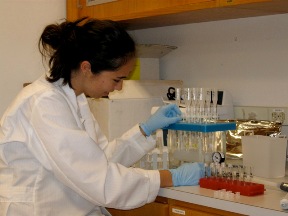 |
||||
Solid Phase Adsorption Toxin Testing: SPATT |
||||
|
Monitoring for marine toxins is a critical component of coastal management. Traditional phycotoxin monitoring uses mussels or other shellfish as "sentinel" species - tissues are routinely analyzed for the presense of toxins. Mussel testing occurs at the Santa Cruz Wharf weekly. |
|||
Domoic acid, which is produced by species of Pseudo-nitzschia and common in Monterey Bay, can remain undetected in shellfish tissue. Our lab is experimenting with a new phycotoxin monitoring tool known as Solid Phase Adsorption Toxin Testing, or SPATT. |
||||
| SPATT employs a synthetic resin contained in a mesh bag. The bags are suspended from ropes under the Santa Cruz Wharf, and absorb dissolved domoic acid from the water. | ||||
| After a week in the water, the SPATT bags are brought back to the lab, where the domoic acid is extracted from the resin. Click here for an example of SPATT results. |  |
|||